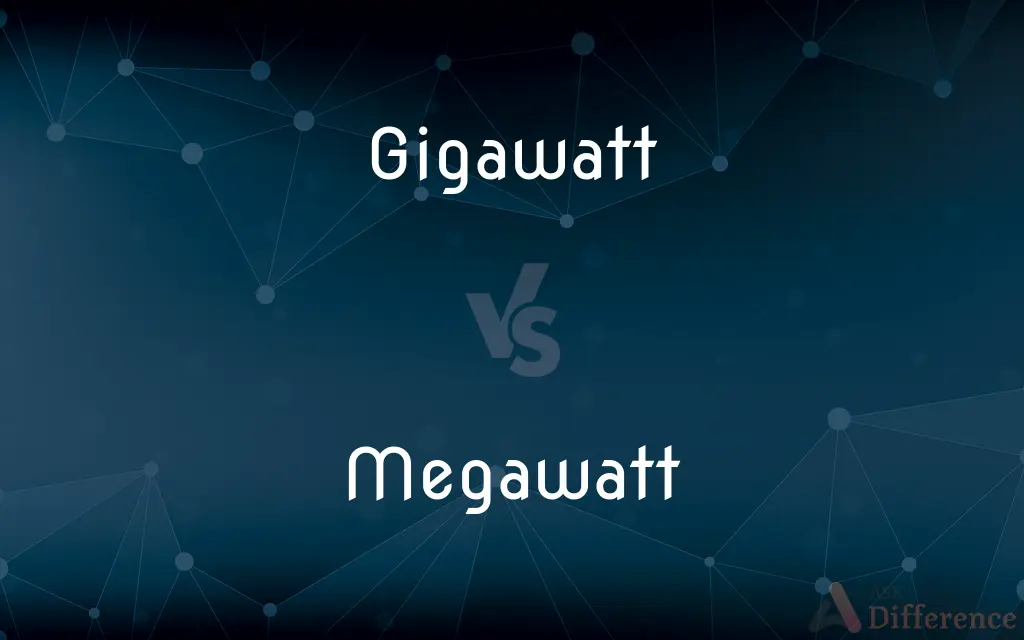Gigawatt vs. Megawatt — What's the Difference?
Edited by Tayyaba Rehman — By Urooj Arif — Updated on March 30, 2024
A gigawatt (GW) is a unit of power equal to one billion watts, while a megawatt (MW) is equal to one million watts, showcasing the scale of energy measurement.

Difference Between Gigawatt and Megawatt
Table of Contents
ADVERTISEMENT
Key Differences
A gigawatt (GW) is a standard unit of power in the International System of Units (SI), representing one billion watts. This measurement is often used to express the output capacity of large power plants or the power consumption of large cities. Whereas, a megawatt (MW) is another SI unit of power, equivalent to one million watts, and is commonly used to describe the scale of medium-sized energy projects like renewable energy installations or small power plants.
Gigawatts are typically invoked in discussions about national or regional energy production and consumption, reflecting the massive scale of energy required to support extensive areas and populations. On the other hand, megawatts are more frequently referenced in the context of local energy projects, such as the power output of a single wind turbine or a small solar photovoltaic farm.
In terms of scale, a single gigawatt is equivalent to 1,000 megawatts, illustrating the vast difference in magnitude between the two. This disparity highlights how energy needs and projects can vary widely, from the immense, grid-scale generation to more localized energy production.
The measurement in gigawatts is crucial for understanding and planning the energy infrastructure needed for future growth and development, especially in the context of increasing demand for renewable energy sources. Meanwhile, megawatts provide a more accessible measure for smaller-scale projects and initiatives, making it easier to grasp the impact and capacity of individual energy solutions.
The usage of gigawatts versus megawatts also signifies the level of technological and financial investment required. Large-scale projects measured in gigawatts often involve significant investment and complex technology, reflecting the serious commitment to meeting the energy demands of a large area. In contrast, megawatt-scale projects can be more feasible and practical for smaller entities, including local governments, businesses, or community initiatives, indicating a more localized focus and investment.
ADVERTISEMENT
Comparison Chart
Scale
1 billion watts
1 million watts
Usage
Large power plants, national energy consumption
Small to medium energy projects, local applications
Equivalent
1,000 megawatts
0.001 gigawatts
Commonality
Less common, used for grid-scale energy discussions
More common for localized projects
Investment
Indicates high technological and financial commitment
Suggests more localized, smaller scale investments
Compare with Definitions
Gigawatt
Measurement used in discussing large-scale energy generation.
Our country's total energy production reaches 5 gigawatts annually.
Megawatt
Commonly used for medium-sized energy projects.
Each turbine in the field generates up to 2 megawatts.
Gigawatt
Reflects the scale of national or regional power needs.
The new solar farm will add 1.5 gigawatts to the national grid.
Megawatt
A unit of power equal to one million watts.
The wind farm's maximum output is 200 megawatts.
Gigawatt
Used to quantify the output of large power stations.
The hydroelectric dam produces 3 gigawatts at peak capacity.
Megawatt
Describes the scale of localized energy solutions.
The biomass facility will provide 50 megawatts of power.
Gigawatt
A unit of power equal to one billion watts.
The nuclear power plant has a capacity of 2 gigawatts.
Megawatt
Reflects smaller-scale energy investments.
A megawatt of solar power can light up a small neighborhood.
Gigawatt
Indicates the potential for significant energy production.
A gigawatt of power can supply electricity to hundreds of thousands of homes.
Megawatt
Measures the capacity of small to medium power plants.
The solar array has a total capacity of 100 megawatts.
Gigawatt
One billion (109) watts.
Megawatt
One million watts.
Gigawatt
One thousand million (109) watts, abbreviated as GW.
Megawatt
One million (1 000 000) watts, abbreviated as MW.
Megawatt
A unit of power equal to one million watts
Common Curiosities
Is gigawatt or megawatt bigger?
A gigawatt is larger, being 1,000 times bigger than a megawatt.
How many megawatts are in a gigawatt?
There are 1,000 megawatts in a gigawatt.
What is a gigawatt?
A gigawatt is a unit of power equal to one billion watts, used to measure the capacity of large power plants or the energy consumption of major areas.
What is a megawatt?
A megawatt is a unit of power equal to one million watts, often used to describe the output of small to medium energy projects.
Why are gigawatts important in energy discussions?
Gigawatts are important because they represent the large scale of energy required for supporting extensive areas and populations.
Can renewable energy sources generate gigawatts of power?
Yes, large-scale renewable energy projects can and do generate gigawatts of power.
How does energy consumption at the gigawatt scale impact the environment?
Energy consumption at the gigawatt scale can have significant environmental impacts, depending on the source of the energy, with renewable sources having less impact than fossil fuels.
What are typical projects that use megawatt-scale power?
Projects like small to medium solar farms, wind farms, and biomass plants typically operate at the megawatt scale.
Can a small city's energy needs be met by megawatts of power?
Yes, the energy needs of a small city can often be met with several hundred megawatts of power.
Are megawatts sufficient for powering industrial facilities?
Many industrial facilities require several megawatts of power, depending on their size and the nature of their operations.
How is a gigawatt of electricity generated?
A gigawatt of electricity can be generated by large power plants using various sources, including nuclear, coal, hydro, and large-scale solar and wind farms.
Can the output of a home solar installation reach a megawatt?
No, home solar installations typically produce kilowatts of power, much less than a megawatt.
What does a megawatt of solar power represent?
A megawatt of solar power represents the output of a solar farm that can supply electricity to several hundred homes, depending on the region and energy usage patterns.
How does the cost compare between gigawatt and megawatt projects?
Gigawatt projects require much larger investments and infrastructure compared to megawatt projects, reflecting the difference in scale and potential impact.
How are gigawatts and megawatts measured?
Both gigawatts and megawatts are measured using instruments that assess the flow of electrical energy over time, such as power meters.
Share Your Discovery

Previous Comparison
Walker vs. Rambler
Next Comparison
Macrohistory vs. MicrohistoryAuthor Spotlight
Written by
Urooj ArifUrooj is a skilled content writer at Ask Difference, known for her exceptional ability to simplify complex topics into engaging and informative content. With a passion for research and a flair for clear, concise writing, she consistently delivers articles that resonate with our diverse audience.
Edited by
Tayyaba RehmanTayyaba Rehman is a distinguished writer, currently serving as a primary contributor to askdifference.com. As a researcher in semantics and etymology, Tayyaba's passion for the complexity of languages and their distinctions has found a perfect home on the platform. Tayyaba delves into the intricacies of language, distinguishing between commonly confused words and phrases, thereby providing clarity for readers worldwide.
















































